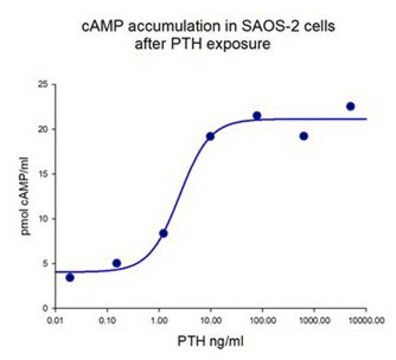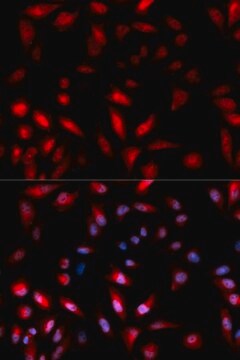SAE0156
Bone Alkaline Phosphatase from human bone osteosarcoma cells
lyophilized, ≥2000 u/mg protein
Sinónimos:
ALPL, BAP, Bone ALP, Ostase
Iniciar sesiónpara Ver la Fijación de precios por contrato y de la organización
About This Item
UNSPSC Code:
12352204
NACRES:
NA.77
Productos recomendados
General description
Mammalian alkaline phosphatases are a group of membrane-bound glycoprotein isoenzymes that are attached to the cell membrane by a hydrophobic glycosyl-phosphatidylinositol (GPI) anchor.
The bone alkaline phosphatase isozyme is expressed from the gene for tissue nonspecific alkaline phosphatase which is also expressed in liver and kidney. These three isoforms form the majority of alkaline phosphatases circulating in serum. All three forms share the same amino acid sequence but have different carbohydrate and lipid modifications that provide unique properties according to the source tissue.
Bone alkaline phosphatase is synthesized by osteoblasts, involved in the calcification of bone matrix, but its precise role in bone formation process is still unknown. It is a highly specific marker of the bone-forming activity of osteoblasts. High activity of bone alkaline phosphatase is observed in serum in several bone diseases, such as Paget′s disease, osteoporosis, ricket disease, bone metastatic carcinoma, and others. Physiological bone growth can also contribute to increased levels of bone alkaline phosphatase in serum.
This product is purified from human osteosarcoma Saos-2 cells, an established cell line with high basal alkaline phosphatase activity. Before purification, alkaline phosphatase is released from the cell membrane by enzymatic cleavage of the GPI anchor.
The bone alkaline phosphatase isozyme is expressed from the gene for tissue nonspecific alkaline phosphatase which is also expressed in liver and kidney. These three isoforms form the majority of alkaline phosphatases circulating in serum. All three forms share the same amino acid sequence but have different carbohydrate and lipid modifications that provide unique properties according to the source tissue.
Bone alkaline phosphatase is synthesized by osteoblasts, involved in the calcification of bone matrix, but its precise role in bone formation process is still unknown. It is a highly specific marker of the bone-forming activity of osteoblasts. High activity of bone alkaline phosphatase is observed in serum in several bone diseases, such as Paget′s disease, osteoporosis, ricket disease, bone metastatic carcinoma, and others. Physiological bone growth can also contribute to increased levels of bone alkaline phosphatase in serum.
This product is purified from human osteosarcoma Saos-2 cells, an established cell line with high basal alkaline phosphatase activity. Before purification, alkaline phosphatase is released from the cell membrane by enzymatic cleavage of the GPI anchor.
Unit Definition
One unit will hydrolyze 1.0 μmole of p-nitrophenyl phosphate to p-nitrophenol and inorganic phosphate per minute at pH 9.8 at 37 °C.
Storage Class
11 - Combustible Solids
wgk_germany
WGK 3
Certificados de análisis (COA)
Busque Certificados de análisis (COA) introduciendo el número de lote del producto. Los números de lote se encuentran en la etiqueta del producto después de las palabras «Lot» o «Batch»
¿Ya tiene este producto?
Encuentre la documentación para los productos que ha comprado recientemente en la Biblioteca de documentos.
Nuestro equipo de científicos tiene experiencia en todas las áreas de investigación: Ciencias de la vida, Ciencia de los materiales, Síntesis química, Cromatografía, Analítica y muchas otras.
Póngase en contacto con el Servicio técnico






